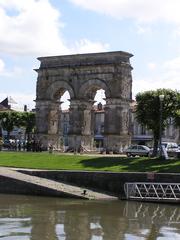
Thermes Romains de Saint-Saloine Visiting Guide with Hours, Tickets, and More
Date: 01/08/2024
Introduction
Nestled in the historic town of Saintes, France, the Thermes Romains de Saint-Saloine stands as a remarkable monument of Roman engineering and cultural heritage. Constructed in the 1st century AD, these thermal baths were part of the Roman town of Mediolanum Santonum, serving as the capital of the Roman province of Aquitaine. The baths were an essential part of daily life in Roman culture, serving not only as a place for bathing but also as a social and recreational hub. Ingeniously channeled water from the Charente River via an aqueduct highlights their advanced engineering skills (source). Over time, the site has transformed, reflecting the dynamic history of the region, including its adaptation into a necropolis during Late Antiquity and later into an early-Christian church. These ruins provide valuable insights into the daily life of the inhabitants of Saintes under Roman rule and the continuity and change in the use of urban spaces over centuries (source).
Table of Contents
- Introduction
- Historical Background
- Visitor Information
- Nearby Attractions
- Historical Significance
- Preservation and Archaeological Efforts
- Connection to Other Roman Sites in Saintes
- Influence on Later Architectural Developments
- Modern-Day Relevance
- Visitor Experience
- Frequently Asked Questions (FAQ)
- Conclusion
Historical Background
Roman Origins
The Thermes Romains de Saint-Saloine are a testament to the grandeur of Roman engineering and urban planning. Constructed in the 1st century AD, these thermal baths were part of the Roman town of Mediolanum Santonum, which served as the capital of the Roman province of Aquitaine. The baths were integral to daily life in Roman culture, serving not only as a place for bathing but also as a social and recreational hub. The water for the baths was ingeniously channeled from the Charente River via an aqueduct, fragments of which can still be seen to the north of the city (source).
Architectural Features
The remains of the Thermes Romains de Saint-Saloine include sections of the walls of the old caldarium, the hot bath area, which was a central feature of Roman baths. Visitors can easily spot the alcoves of the caldarium, which were used to hold hot water. The site also includes stones from the Saint-Saloine church, a later building that was abandoned in the 16th century (source). The architectural ingenuity of the Romans is evident in the layout and construction of these baths, which were designed to maximize the use of natural resources and provide a luxurious experience for their users.
Transformation into a Necropolis
During Late Antiquity, the baths were abandoned and the building was adapted into an early-Christian church. This transformation is how the ruins came by their name, Saint-Saloine. Archaeological excavations at the site have unveiled many ancient and medieval sarcophagi, indicating that the area was subsequently transformed into a necropolis (source). This dual use of the site highlights the continuity and change in the use of urban spaces over centuries.
Visitor Information
Visiting Hours and Tickets
The Thermes Romains de Saint-Saloine are open to visitors throughout the year. However, it is advisable to check the latest visiting hours on the official Saintes tourism website or contact the Saintes tourist office for up-to-date information (Saintes Tourisme). Ticket prices are generally affordable, with discounts available for children, students, and seniors. Group tours can be arranged in advance.
Travel Tips
The site is easily accessible by car and public transport. Parking is available nearby, and the town of Saintes is well-connected by train and bus services. Comfortable walking shoes are recommended as the terrain around the ruins can be uneven.
Nearby Attractions
While visiting the Thermes Romains de Saint-Saloine, make sure to explore other Roman ruins in Saintes, including the impressive amphitheatre and the Arch of Germanicus. The town itself offers a range of historical sites, museums, and charming streets to explore.
Historical Significance
The Thermes Romains de Saint-Saloine are classified as Historical Monuments, underscoring their importance in the historical and cultural landscape of Saintes. These ruins provide valuable insights into the daily life of the inhabitants of Saintes under Roman rule. The baths were not merely places for hygiene but were integral to the social fabric of Roman society, serving as venues for relaxation, exercise, and social interaction. The presence of sarcophagi also indicates the site’s significance as a burial ground, reflecting the changing religious and cultural practices over time (source).
Preservation and Archaeological Efforts
The preservation of the Thermes Romains de Saint-Saloine has been a focus of archaeological efforts in Saintes. Excavations have revealed not only the structure of the baths but also numerous artifacts that provide a glimpse into the lives of the people who used them. These efforts have been crucial in understanding the broader historical context of the site and its evolution over time. The classification of the site as a Historical Monument has helped ensure its protection and conservation for future generations (source).
Connection to Other Roman Sites in Saintes
The Thermes Romains de Saint-Saloine are part of a larger network of Roman ruins in Saintes, which include the amphitheatre, arches, and countless fragments of sculpture and stonework. These sites collectively paint a vivid picture of the town’s Roman past. The amphitheatre, dating to the rule of Emperor Claudius in 40 AD, could seat up to 15,000 spectators and is one of the finest remnants of ancient Mediolanum Santonum (source). The interconnectedness of these sites highlights the town’s significance as a major urban center in Roman Gaul.
Influence on Later Architectural Developments
The architectural and engineering techniques used in the construction of the Thermes Romains de Saint-Saloine influenced later developments in the region. The use of aqueducts to channel water, the design of the caldarium, and the overall layout of the baths were innovations that were adopted and adapted in subsequent architectural projects. The transformation of the site into a necropolis and later into a church also reflects the adaptability of Roman architectural forms to new functions and cultural contexts (source).
Modern-Day Relevance
Today, the Thermes Romains de Saint-Saloine continue to attract visitors and scholars interested in Roman history and archaeology. The site offers a tangible connection to the past, allowing visitors to walk through the remnants of a once-thriving Roman spa. The preservation of the site and the ongoing archaeological research contribute to our understanding of Roman urban life and its legacy in modern Europe. The site’s classification as a Historical Monument ensures that it remains a protected and valued part of Saintes’ cultural heritage (source).
Visitor Experience
For visitors, the Thermes Romains de Saint-Saloine offer a unique opportunity to explore a significant historical site. The ruins, though not extensive, provide a fascinating glimpse into Roman engineering and daily life. The nearby Saint-Saloine church and the sarcophagi add layers of historical intrigue, making the site a must-visit for history enthusiasts. The Saintes tourist office provides information and guidance on exploring the site and its connections to other Roman ruins in the town (source).
Frequently Asked Questions (FAQ)
Q: What are the visiting hours for the Thermes Romains de Saint-Saloine?
A: The visiting hours can vary, so it is best to check the official Saintes tourism website or contact the tourist office for the most up-to-date information.
Q: How much are tickets for the Thermes Romains de Saint-Saloine?
A: Ticket prices are generally affordable, with discounts available for children, students, and seniors. Group tours can also be arranged in advance.
Conclusion
In summary, the Thermes Romains de Saint-Saloine are a remarkable historical site that offers insights into Roman engineering, social life, and the evolution of urban spaces over centuries. The site’s preservation and archaeological significance make it an essential part of any visit to Saintes, France. Don’t miss the opportunity to explore this captivating remnant of ancient history and its surrounding attractions (source, source).
References
- The Crazy Tourist, n.d., 15 Best Things to Do in Saintes (France) (source)
- Spotting History, n.d., Thermae of Saint-Saloine (source)
- Ville de Saintes, n.d., Les incontournables - Thermes de Saint-Saloine (source)
- France Voyage, n.d., Thermal Baths of Saint-Saloine (source)
- Saintes Tourisme, n.d., Saint-Saloine Baths (source)
- Google Arts & Culture, n.d., Saintes: Roman Capital - Fondation du Patrimoine (source)
- Wikipedia, n.d., Thermes de Saint-Saloine de Saintes (source)



